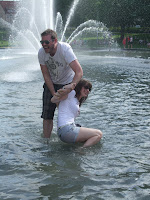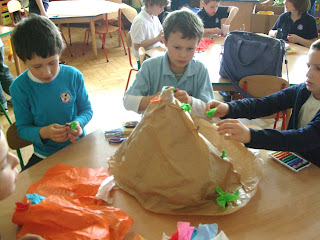As I spend more time in
my placement school I am becoming more familiar with the principles of the
curriculum they follow – the International Baccalaureate- and the benefits that
these can bring to the classroom. This week I have been thinking more about the
‘Key Concepts’ used when teaching the Unit of Inquiry, which for my class at
the moment is Natural Disasters. There are six Key Concepts which are used in
every class to help structure learning.
Form: What is it like?
Causation: Why is it
like it is?
Change: How is it
changing?
Connection: How is it
connected to other things?
Perspective: What are
the points of view?
Responsibility: What is
our responsibility?
Reflection: How do we
know?
These concepts are
written on large keys, as their purpose is to help unlock knowledge and
understanding. The teacher selects the specific ones which are appropriate to
the lesson and uses these to establish what the children already know and what
they want to know, similar to the use of KWL boards in Northern Ireland. Isbell
and Raines (2012:296) highlight that, ‘KWL charts are useful for keeping track
of the inquiries that drive the children’s investigations and as a way to
document what has been learned.’ While similar in their objectives, I feel that
KWL charts can be more effective as they provide a visual stimulus and
reminder, whereas the Key Concepts are only done verbally and therefore can be
easily forgotten by the children. Hoffman and Schallert (2008:145) discuss the
benefits of, ‘coordinating the presentation of verbal and visual information to
maximise learning.’ While noting this, it is important to consider that the Key
Concepts could be used in a variety of ways like this to make them more
effective.
The Key Concepts help
to make connections between what is being learnt in the classroom and real
life. For example, in this Natural Disasters Unit of Inquiry, the children are
not just learning facts about volcanoes, but also the impact which volcanoes
have on people’s lives. This helps to make the learning more real and relevant
and something which the children can relate to more.
While observing these ideas being used in the classroom I was able to compare these with the ‘Change over time’ strand of the World Around Us section in the Northern Ireland Primary Curriculum (CCEA, 2007:87) such as ‘Change over time’, ‘Interdependence’ and ‘Place’. These two primary school curricula seem to be rather similar, particularly as in the IB, the Key Concepts are only used when teaching the Unit of Inquiry which is very similar to the World Around Us subject area in the Northern Ireland Primary Curriculum.
The GTCNI Competence 14
(2006: 14) states that, ‘Teachers will set appropriate learning
objectives/outcomes/intentions, taking account of what pupils know, understand
and can do.’ Through experiencing the focus on methods such as using Key
Concepts I feel I am further developing this competence and a variety of
strategies which can be used to fulfil it.
Thinking ahead about
how little time I have left to explore more into this education system, I am
looking forward to the ‘school sleepover’ I have been invited to attend in two
weeks time, in which all classes stay overnight in the school! I am very
excited to see what this will be like, as it is definitely something I have
never heard of in Northern Ireland!
 |
 |
The three of us enjoying the 30 degree heat!
References:
-CCEA (2007) The Northern Ireland Primary School
Curriculum, Belfast: CCEA Publications
-General Teaching Council
for Northern Ireland (2006) Teaching: The
Reflective Profession: Belfast.
-Hoffman, J. and
Schallert, D. (2008) The Texts in
Elementary Classrooms, New Jersey: Lawrence Erlbaum Associated, Ltd.
-Isbell, R. and Raines,
S. (2012) Creativity and the Arts with
Young Children 3RD edition, Cengage Learning.


No comments:
Post a Comment